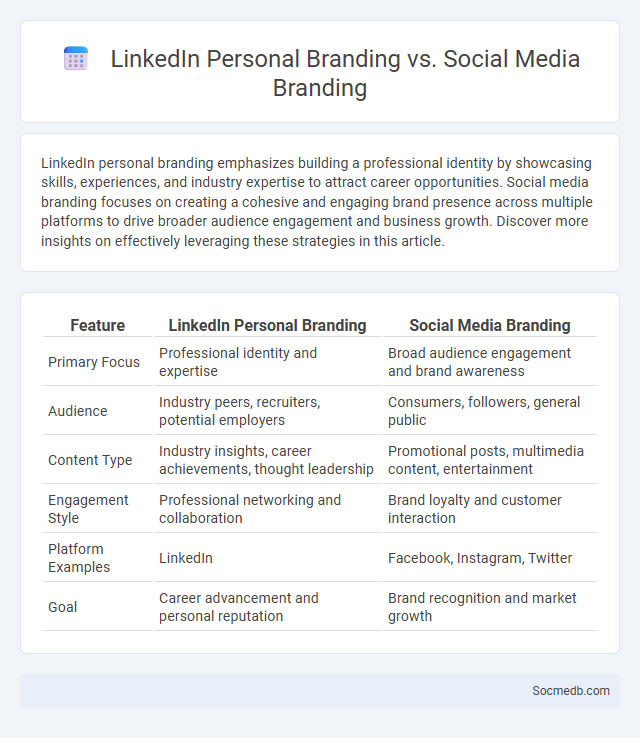
Photo illustration: LinkedIn Personal Branding vs Social Media Branding
LinkedIn personal branding emphasizes building a professional identity by showcasing skills, experiences, and industry expertise to attract career opportunities. Social media branding focuses on creating a cohesive and engaging brand presence across multiple platforms to drive broader audience engagement and business growth. Discover more insights on effectively leveraging these strategies in this article.
Table of Comparison
| Feature | LinkedIn Personal Branding | Social Media Branding |
|---|---|---|
| Primary Focus | Professional identity and expertise | Broad audience engagement and brand awareness |
| Audience | Industry peers, recruiters, potential employers | Consumers, followers, general public |
| Content Type | Industry insights, career achievements, thought leadership | Promotional posts, multimedia content, entertainment |
| Engagement Style | Professional networking and collaboration | Brand loyalty and customer interaction |
| Platform Examples | Facebook, Instagram, Twitter | |
| Goal | Career advancement and personal reputation | Brand recognition and market growth |
Understanding Personal Branding: Core Concepts
Personal branding revolves around creating a distinct and consistent online identity that reflects an individual's values, skills, and personality across social media platforms. It involves strategic content creation, audience engagement, and leveraging social proof such as reviews and testimonials to build credibility. Effective personal branding enhances professional opportunities by increasing visibility and fostering trust within target communities.
What is Social Media Branding?
Social media branding involves creating a consistent and recognizable identity for your business across platforms like Facebook, Instagram, and Twitter to engage your target audience effectively. It uses strategic content, visuals, and messaging tailored to your brand's values and goals, enhancing visibility and trust. Your social media presence becomes a powerful asset that drives customer loyalty and differentiates you from competitors in the digital marketplace.
The Rise of LinkedIn Personal Branding
LinkedIn personal branding has surged as professionals leverage the platform's 900 million users to showcase expertise and expand networks within industries such as technology, finance, and marketing. By consistently sharing thought leadership content and engaging in niche groups, users boost visibility, attracting recruiters and business opportunities. Enhanced LinkedIn profiles with rich media, endorsements, and strategic keywords optimize searchability, solidifying individual credibility in today's digital job market.
Key Differences: LinkedIn vs Social Media vs Personal Branding
LinkedIn emphasizes professional networking and industry-specific content, making it ideal for career growth and B2B engagement, unlike broader social media platforms such as Facebook and Instagram that prioritize casual interactions and entertainment. Social media fosters diverse content types including videos, memes, and personal updates, whereas LinkedIn centers on professional achievements, thought leadership, and resume building. Personal branding on LinkedIn involves showcasing expertise and industry credibility, while on other social media channels it often blends personal lifestyle with brand storytelling to connect emotionally with audiences.
Strategic Objectives: Why Each Branding Approach Matters
Different social media branding approaches target specific strategic objectives such as increasing brand awareness, boosting customer engagement, and driving conversions. Your choice of branding strategy impacts how effectively you communicate your unique value proposition and build trust with your audience. Clear alignment between branding tactics and your overarching business goals ensures measurable growth and lasting customer loyalty.
Target Audience Engagement Across Platforms
Maximizing target audience engagement across social media platforms requires understanding user behavior and preferences on each channel. You must tailor content that resonates with specific demographics while leveraging platform features like stories, live videos, and interactive polls. Consistent analytics review ensures your strategies adapt to shifting audience interests and platform algorithms.
Content Creation Strategies for Maximum Brand Impact
Effective content creation strategies for social media prioritize audience engagement through personalized, relevant posts that align with brand identity and values. Leveraging data analytics to monitor performance metrics enables brands to refine content types, posting times, and formats for maximum reach and interaction. Integrating multimedia elements such as videos, infographics, and user-generated content enhances storytelling and builds authentic connections, driving stronger brand awareness and loyalty.
Authenticity & Credibility in Branding Efforts
Authenticity and credibility are essential pillars in social media branding efforts, fostering genuine connections with audiences and enhancing trust. Brands that share transparent stories, provide consistent, truthful information, and engage respectfully with followers build meaningful loyalty and long-term reputation. Leveraging user-generated content, real testimonials, and behind-the-scenes insights boosts brand integrity and drives higher engagement rates.
Measuring Success: Metrics for Each Branding Type
Measuring success on social media requires tailored metrics based on branding types: awareness brands focus on reach and impressions to gauge visibility, engagement brands prioritize likes, comments, shares, and interaction rates to assess audience connection, while conversion-driven brands track click-through rates, lead generation, and sales attributed to social media campaigns. For influencer branding, metrics such as follower growth, engagement rate, and brand mentions provide insight into influence effectiveness. Data analytics tools like Google Analytics, Hootsuite, and Sprout Social facilitate comprehensive tracking and reporting across platforms.
Choosing the Right Branding Path for Your Goals
Choosing the right branding path for your goals involves identifying your target audience and aligning your social media content with their preferences and needs. Tailoring your visual identity, messaging, and platform selection ensures consistent brand awareness and engagement across channels like Instagram, LinkedIn, or TikTok. Your strategic focus on these elements maximizes ROI and builds a loyal online community that supports long-term growth.
 socmedb.com
socmedb.com